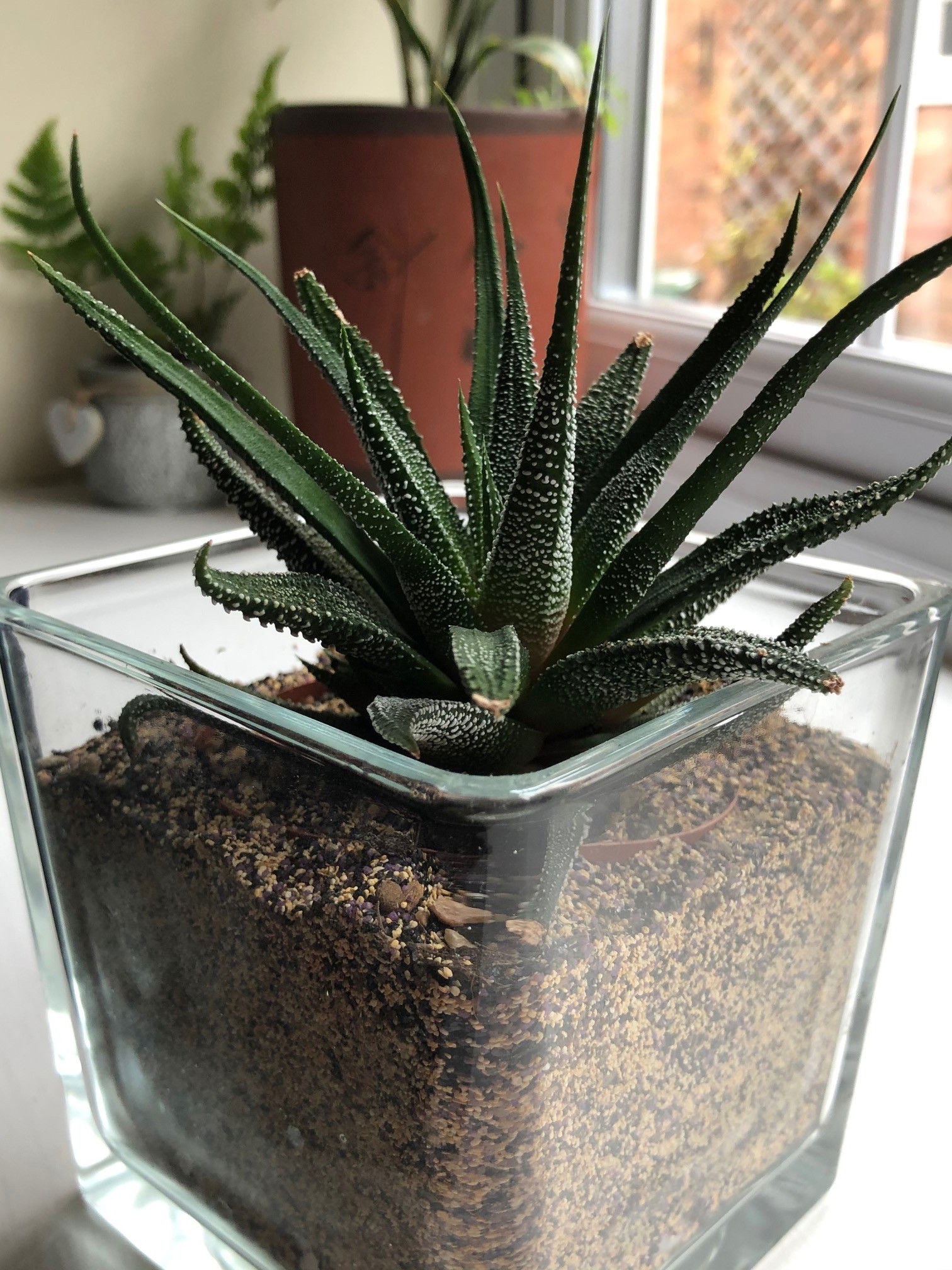
Haworthiopsis* attenuata var. radula. (*Read 'Origins' to learn why this specimen isn't named 'Haworthia' anymore).
Contents
- Top Tips
- Location, Water, Humidity & Fertilisation
- Common Issues
- Origins, Temperature, Propagation, Repotting & Toxicity
Need the answer to a specific plant query? Book a 1-to-1 video call with THE HOUSEPLANT DOCTOR™ (Author of ukhouseplants.com), to overcome and address your niggling problem! Available on iMessage, WhatsApp, Facebook Messenger & more.
Top Tips & Info
- Care Difficulty - Easy
- A few hours of morning or evening sun is mandatory, especially in the winter months
- Haworthia must endure periods of droughts in between waters - if you're stuck with when to water it, think of the ukhouseplants' phrase of 'Drenches Between Droughts'.
- Be careful when watering - allowing excess moisture to sit in the cubbyholes of the stem will result in diseases like southern blight and 'heart rot'.
- Fertilise every two or three months using either a 'Cactus' or 'Houseplant' labelled feed.
- Repot three years during the spring, using a 'Cactus & Succulent' potting mix. This is the perfect time to propagate the basal offsets (pups) that'll form at the base of the crown. Be gentle with their root systems - especially with the 'pups' that can easily be snapped off during a transplant.
- Haworthia are perfect for a desert-themed terrarium or display due to the slow growth habits and interesting foliar patterns.
Location & Light - 🔸🔸🔸
Haworthia can withstand all levels of indirect light - ranging from a windowsill to a semi-shaded shelf. Not only this, but this genus can also become acclimated to partial sunlight, too. If you're interested in placing yours in a brighter environment, gradually increase the light levels over the course of a few weeks to prevent the risk of environmental shock or sun-scorch. For those in a shadier area, be sure to keep the specimen on the drier side to avoid the large risk of 'heart rot'.
Water - 🔸
Allow all of the soil to dry out in between waters, reducing this to once a month in the autumn and winter. One word of advice is never to allow excess moisture to settle either in the actual crown of the plant or underneath the pot, as both will cause southern blight or even black rot. Under-watering symptoms include drooping leaves, stunted growth, and drying leaves; these can be a range of different issues, including forgetfulness, too much sunlight, or the plant being pot-bound. Over-watering symptoms include root rot, a rotting base, or sudden plant death. Haworthia must have sufficient light levels (at least two hours of direct sunlight a day) to counteract the chance of root rot, if you're an avid over-waterer. For more severe cases, click on this link below to learn about how to address root rot.
Humidity -
This is not a factor; however, if the Haworthia is situated indoors, a quick hose down from time to time will reduce the number of dust particles covering its leaves.
Fertilisation - 🔸
Fertilise every two months during the growing period and every three months in the autumn & winter to replicate its dormancy period. Although a 'Houseplant' fertiliser will still do the job, we'd recommend using a specific 'Cactus' labelled feed as it'll support the vital thirteen nutrients that this species will need to grow.
 Haworthia 'West Jogoo'
Haworthia 'West Jogoo'
Common Issues with Haworthia
If you still can't find the answer to your specific houseplant problem, book a 1-to-1 video call with THE HOUSEPLANT DOCTOR™ to point you in the right direction today.
Over-watering is the most common issue, with typical signs including a rapidly yellowing older leaves (those closet to the soil) and overly moist soil that takes a while to dry out. There must be periods of droughts to replicate the habitats of the east African deserts, as well as limiting the chance of diseases. Avoid waterlogging as there's no point fulfilling the phrase 'drenches between droughts' if the base of the pot is submerged. For more information about over-watering related issues, be sure to click on this link. See image below of an example of Root Rot.
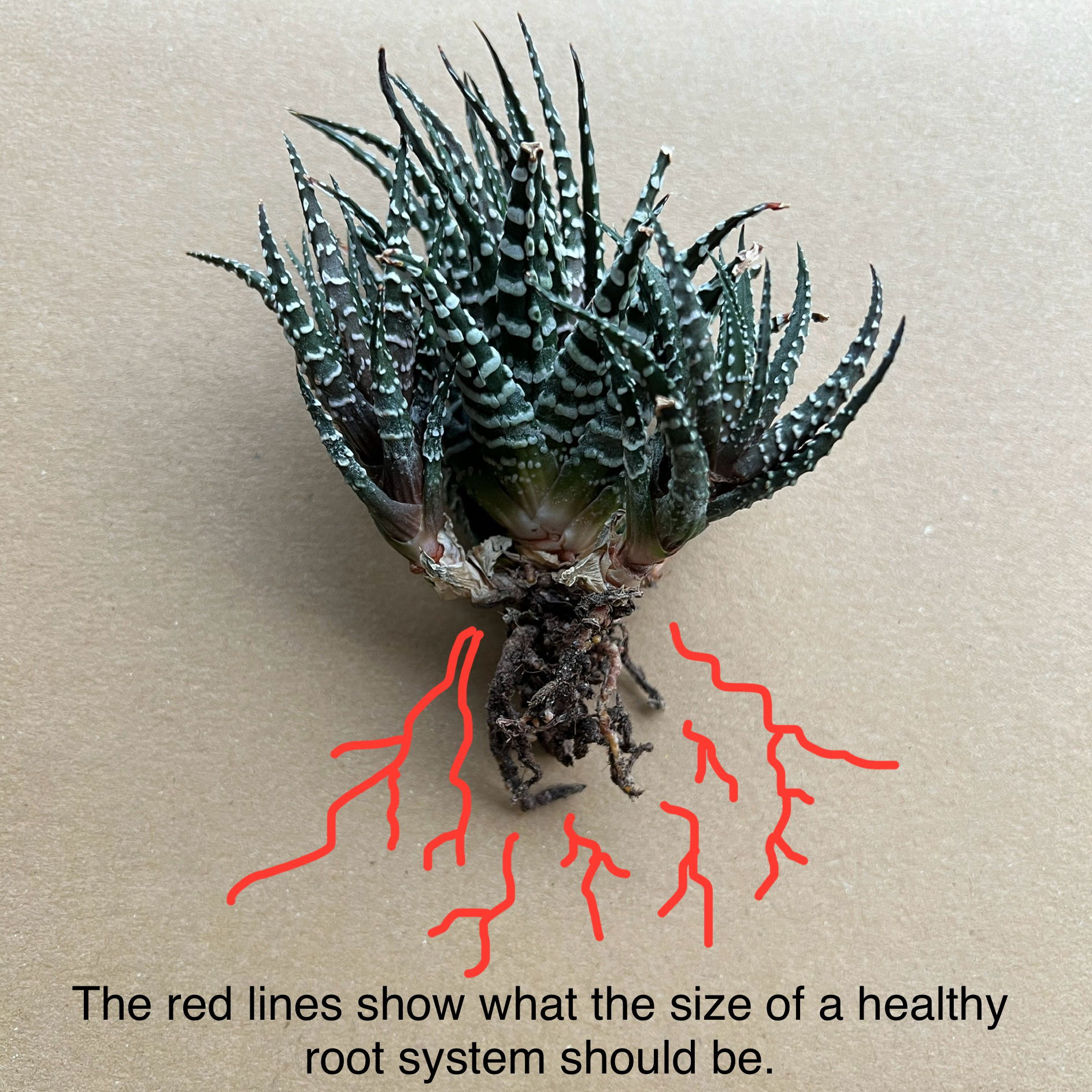 The red lines show the size of what a healthy Haworthia should look like. If your Zebra Cactus has root rot (picture above), apply a rooting gel on the roots before repotting in a 7cm pot with ‘Cactus’ soil for rehabilitation. Provide a bright windowsill & only rehydrate the soil once the top third dries out.
The red lines show the size of what a healthy Haworthia should look like. If your Zebra Cactus has root rot (picture above), apply a rooting gel on the roots before repotting in a 7cm pot with ‘Cactus’ soil for rehabilitation. Provide a bright windowsill & only rehydrate the soil once the top third dries out.
A pale centre and deformed growth are typical signs of too little light. Offer at least an hour of direct sunlight, especially in the winter months, to provide the vital nutrients that'll be converted into plant sugars.
Reddened or browned leaves are the result of too little water and over-exposure to the sun. Although Haworthia are a superb choice for plants in sunny locations, those that haven't acclimatised to the harsh rays will show signs of sun-scorch and environmental shock. Prolonged exposure will significantly speed the process of dehydration, so consider transplantation into a bigger pot (in the spring) to wrap the roots around moister soil.
Over-supplementing a Haworthia will bring nothing but grief in the likes of yellowing leaves and weak, dramatic growth. Although regular feeds are an excellent way to promote good health, dry soil and fertiliser salts will quickly lead to the burning of roots. The advice for this issue is to pre-moisten the soil beforehand and reduce the frequency of fertilisations somewhat.
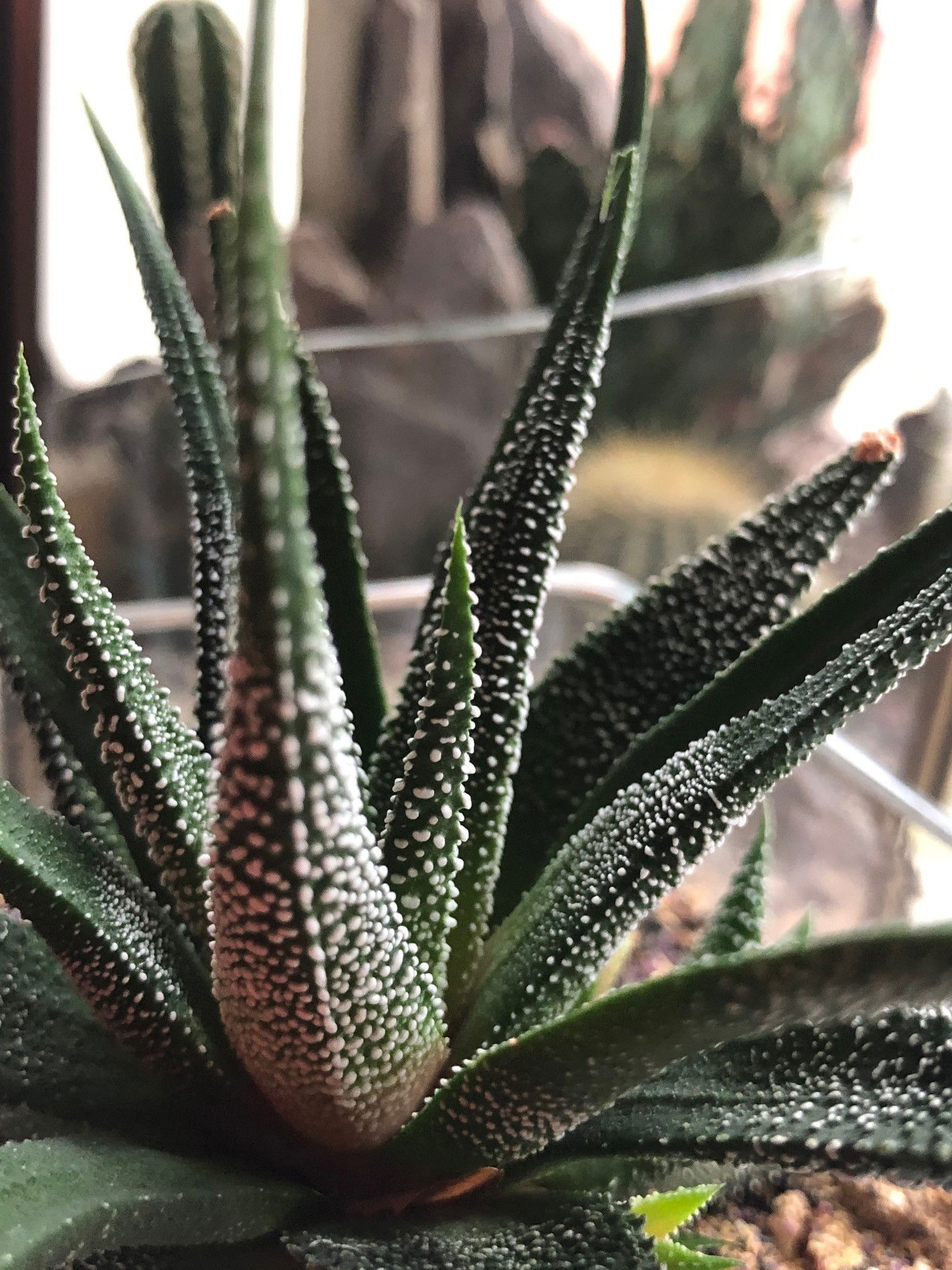 What are the white markings on a Zebra Succulent? These are scientifically known as 'tubercles' that allow the slight swelling/expansion of a Haworthia's leaf during the rainy season without tearing its outer-skin. Plant: Haworthiopsis attenuata var. radula
What are the white markings on a Zebra Succulent? These are scientifically known as 'tubercles' that allow the slight swelling/expansion of a Haworthia's leaf during the rainy season without tearing its outer-skin. Plant: Haworthiopsis attenuata var. radula
Origins
Haworthia consists of over sixty species, originating from semi-deserted locations in southern Africa. The genus was first described back in the 18th century, but its true taxonomy has been greatly argued over the last century. The movement of species within the genus has been empathised by new research into the polyphyletic construction. Previous subgenera like Haworthiopsis, Tulista and Gasteria have now been placed in their own genera. To save confusion between the genera within the article, 'Haworthia' will act as an umbrella name for all genera and subgenera. The name was penned by Duval in honour of Adrian Hardy Haworth, an English botanist in the 19th century who classified many plants throughout his working life, such as the Orchid Cactus, Fishbone Cactus and the Queen of the Night Succulent.
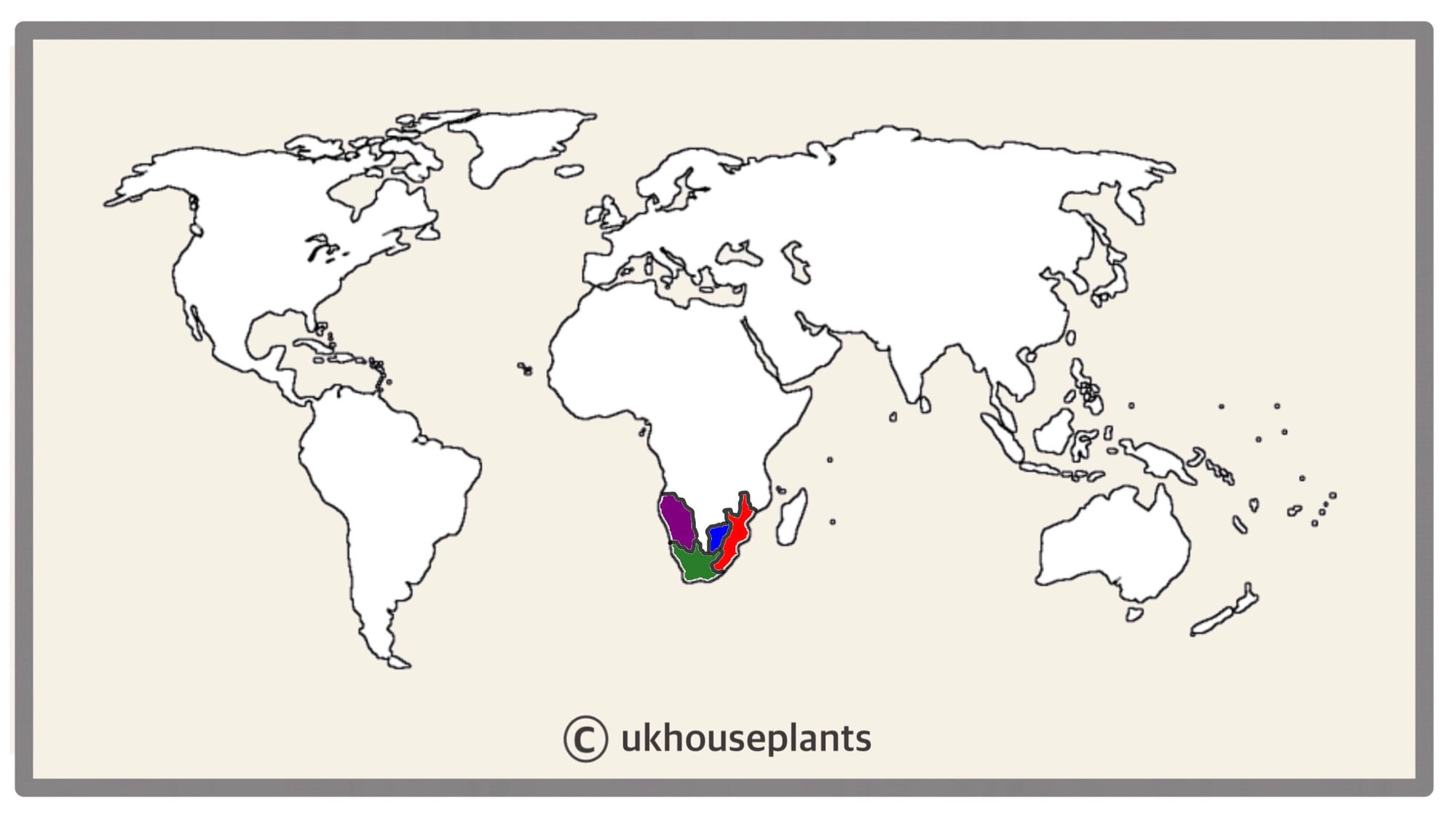 The Distribution of Haworthia in Green, Gasteria and Haworthiopsis in Purple, Green & Red, and Tulista in Green.
The Distribution of Haworthia in Green, Gasteria and Haworthiopsis in Purple, Green & Red, and Tulista in Green.
Temperature
10° - 25°C (50° - 78°F)
H1b (Hardiness Zone 12) - Can be grown outdoors during the summer in a sheltered location with temperatures above 12℃ (54℉), but is fine to remain indoors, too. If you decide to bring this plant outdoors, don't allow it to endure any direct sunlight as it may result in sun-scorch and dehydration. Regularly keep an eye out for pests, especially when re-introducing it back indoors.
Spread
Most species will reach heights of 0.2m in height and 0.4m in width. Ultimate height will be reached within 5 - 8 years.
Pruning & Maintenance
Remove older yellow or dying leaves around its base to encourage better-growing conditions. While pruning, always use clean utensils or shears to reduce the chance of bacterial and fungal diseases.
Propagation
Via Seed, Offset Division or Stem Cuttings.
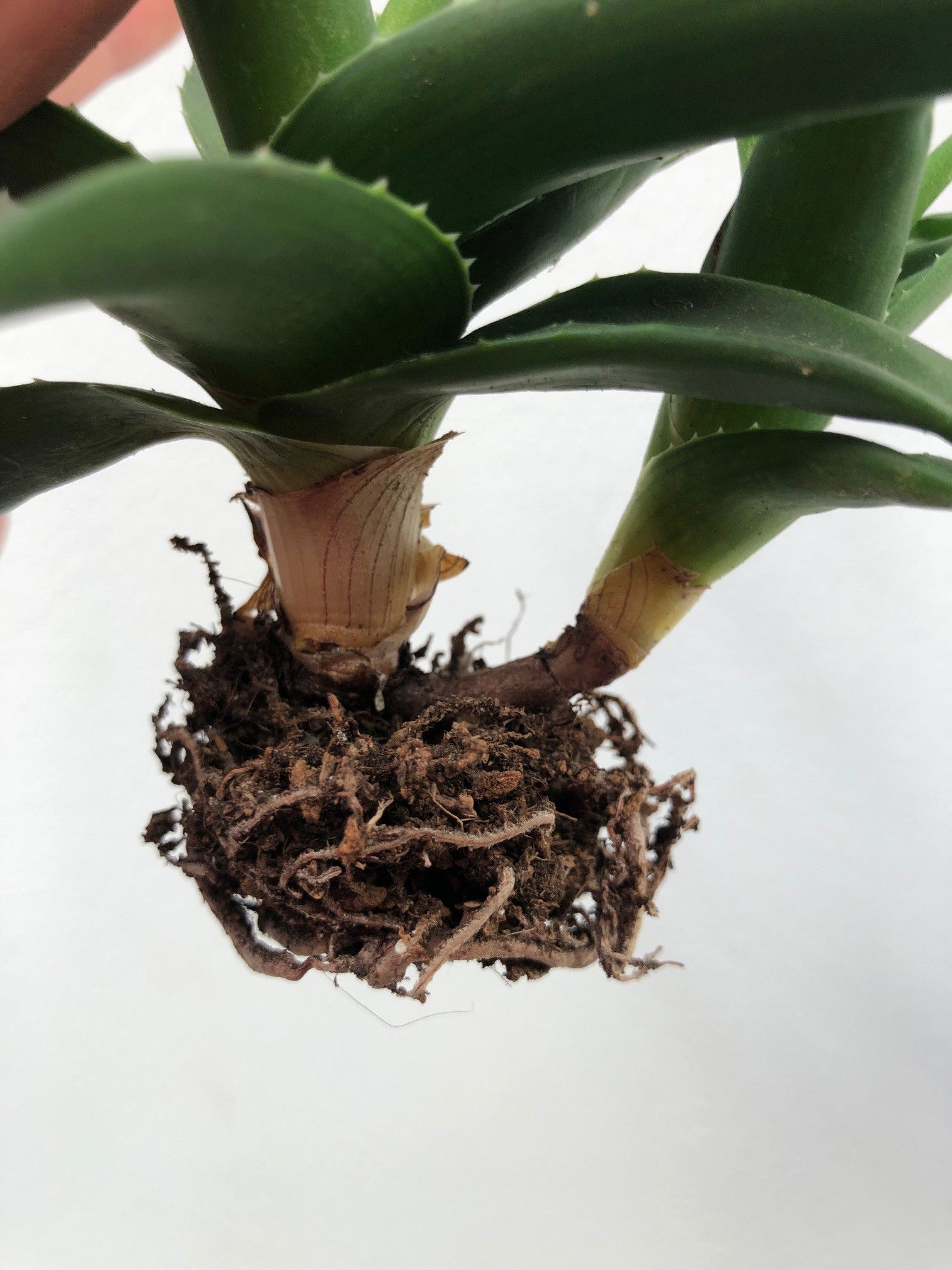 The right hand-side growth is the ideal 'pup' to propagate from due to it's established size & good root system. Plant: Haworthia 'West Jogoo'.
The right hand-side growth is the ideal 'pup' to propagate from due to it's established size & good root system. Plant: Haworthia 'West Jogoo'.
Basal Offset (Pup) Division (Easy) - For this method, it's best to divide in spring or summer and once the offshoots are at least a quarter of the mother plant's size. Remove its pot and place your hand in between the junction that connects the two; soil may have to be brushed away to get a better grip. Gently push the pup downwards while supporting the mother plant until you hear a snap. Cautiously separate the root systems, keeping great care in keeping them damage-free. Place the new plantlet in a small pot with a well-draining potting mix, much similar to the original soil, and maintain the same care routines. 'Cactus & Succulent' compost is best, or you can make your own using multipurpose compost with added grit or perlite. Provide a bright setting with temperatures around 18°C (64°F) with the majority of the soil drying out in between waters. New leaves should emerge within the six weeks, as long as the soil is kept on the drier to life.
Stem Cuttings (Succulents) (Easy) - Using a clean pair of scissors, cut a 10cm (4 - 5 inches) section off the stem's terminal. Be sure to use a fresh, damage or pest-free piece as unhealthy divisions are more likely to fail. Remove the older half of the leaves, so that the stem's lower portion is bare, to speed the process of root development. Purchase a 'Cactus & Succulent' compost and vertically push the cutting's base into the soil, avoiding the risk of covering the actual foliage with soil. Situate the cutting in a bright, indirect setting with temperatures above 18°C (64°F). As the roots will develop first, remove the bag and treat it as an adult specimen once there are signs of new foliar development.
Flowers
Yellow, red, pink or white flowers are held by a spike thatch reach heights of 30cm per summer. Each flower can last up to several days, with the blooming process lasting several weeks.
Haworthia may flower in the height of summer if its previous dormancy period has been served well. The quality of its blooms largely relies on the quality of the dormancy period served in the previous winter.
To replicate its dormancy period:
- Reduce temperatures down to around 12°C (54°F) from late autumn until early spring, with little hydrations or fertilisation.
- Allow all of the soil to dry out for at a fortnight in between irrigations thoroughly, and never apply cold water as this may damage the roots.
- Provide a few hours of off-peak direct sunlight with one fertilisation throughout this period, until the first bud develops at the end of spring.
Repotting
Repot every two to three years in spring using a 'Cactus & Succulent' labelled potting mix and the next sized pot with adequate drainage. Haworthias are a 'family plant' and therefore the mother plant can happily grow with its pups for many years, even if this means over-filling the pot. They prefer to be potbound as this will downplay the risk of over-watering (& root rot), so only repot if necessary or if you're interested in propagating the offsets to expand your spiky collection!
If you were to repot your Haworthia, hydrate the soil 24hrs before tinkering with the roots to prevent the risk of transplant shock. Use a 'Cactus & Succulent' labelled potting mix and the next sized pot, unless the rootball is significantly reduced due to the propagation of pups. We recommend using a terracotta pot as this will help with drainage and moisture absorption.
Book a 1-to-1 video call with Joe Bagley if you'd like a personal guide to repotting your houseplant. This will include recommending the right branded-compost and pot size, followed by a live video call whilst you transplant the specimen for step-by-step guidance and answer any further questions!
Pests & Diseases
Keep an eye out for mealybugs, scale, whitefly, vine weevils & root mealybugs that'll locate themselves in the cubbyholes and undersides of the leaves, with the exception of the latter two in the soil. Common diseases associated with Haworthia are root rot, botrytis, rust & southern blight - click here to learn more about these issues.
Toxicity
This plant is classified as non-poisonous. If large quantities of the plants are eaten, vomiting, nausea and a loss of appetite could occur.
Retail Locations
IKEA, Online Stores.
Book a 1-to-1 Call with THE HOUSEPLANT DOCTOR™
If you need further advice with your houseplants, book an advice call with ukhouseplants' friendly and expert writer today! This can be done via a video or audio call on most apps, including Facebook, FaceTime & Skype. A ten-minute call costs £5.99 (US$7), or £15.99 for thirty minutes. You can ask multiple questions, including queries on plants, pests, terrariums, repotting advice and anything in between. Please consider supporting this service to keep ukhouseplants thriving!